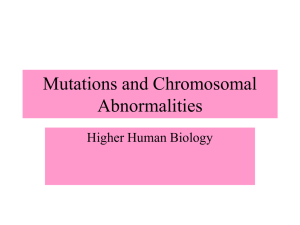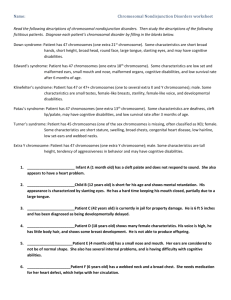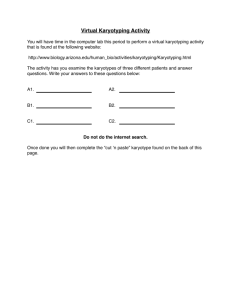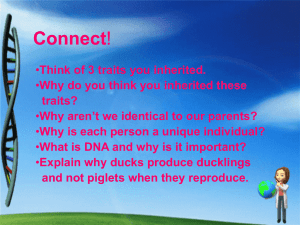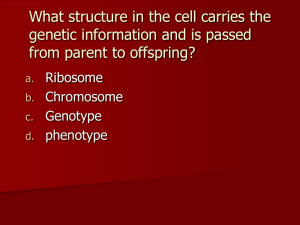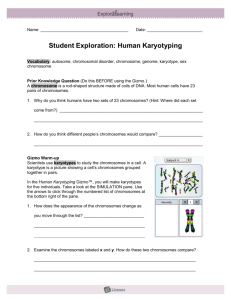Genetics Presentation
advertisement
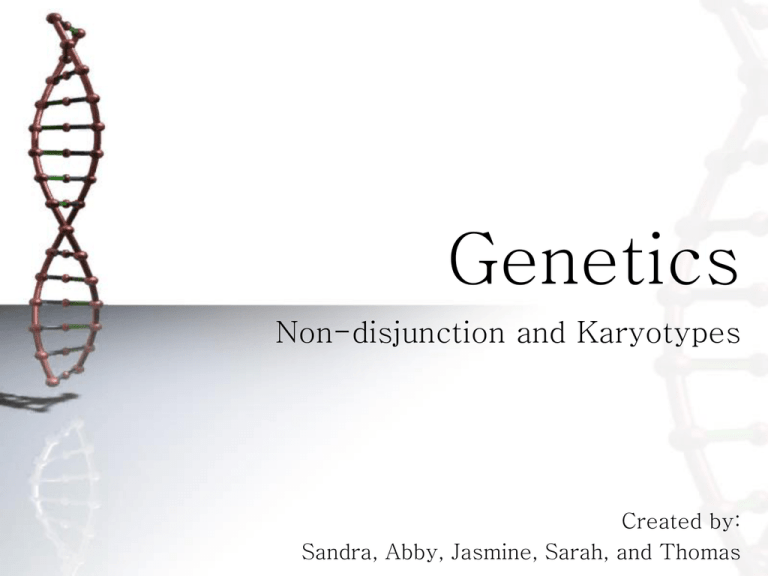
Genetics Non-disjunction and Karyotypes Created by: Sandra, Abby, Jasmine, Sarah, and Thomas Important Definitions • Genotype- refers to the alleles of an organism. Written using upper case and lower case letters. – ie Tt • Phenotype-includes all characteristics of an organism. Written as a word. – ie. Tall • Dominant allele- has the same affect on the phenotype whether it is present in the homozygous or the heterozygous state. – ie Tt and TT are tall Definitions continued • Recessive allele- only has an effect on the phenotype in the homozygous state. – ie tt is tall • Codominant alleles- a pair of alleles that both affect the phenotype when present in a heterozygote. • Locus- the particular position on homologous chromosomes of a gene • Homozygous- having two identical alleles of a gene. – ie tt or TT Definitions continued • Heterozygous-two different alleles of a gene. ie Tt • Carrier- a heterozygous individual that has one copy of a recessive allele that causes a genetic disease in individuals that are homozygous for this allele. • Test cross- refers to testing a suspected heterozygote by crossing with a known homozygous recessive. What is Non-disjunction? • When chromosomes do not separate properly during meiosis, either in meiosis I (in anaphase I) or meiosis II (in anaphase II). • This failure to separate can lead to aneuploidy (having one extra or missing chromosome) or polyploidy (having one complete extra set of chromosomes). Non-disjunction video http://www.biostudio.com/d_%20Meiotic%20Nond isjunction%20Meiosis%20I.htm Non-disjunction in Down Syndrome • Down Syndrome is an example of a genetic disease caused by non-disjunction. – This can be seen through karyotyping when there are three chromosomes in the 21st pair. Down Syndrome • Down syndrome is a result of aneuploidy. If non-disjunction occurs in either parent, one of the 2 gametes will have 2 copies of chromosome 21. So, when the zygote is formed it will contain 3 copies of chromosome 21 and will be aneuploid. AKA: trisomy 21 – (tri=3 somy=chromosomes) Factors affecting chances of Down Syndrome • Age – Females= gametes develop before birth, so the age of the woman is the age of egg cells. The older the woman, the more damage the cells have endured. – Males= sperm is constantly produced so the age of father has less effect than age of mother. • Family history – If a relative has down syndrome, the person has an increased chance. Karyotyping • Karyotyping: process of finding the chromosomal characteristics of a cell • Chromosomes are arranged in pairs according to their size and structure starting with the largest How Karyotyping is Done • Common pre-natal tests for diagnosis of chromosome abnormalities: • chorionic villus sampling (CVS) – CVS: can be done at 11-12 weeks. Involves taking sample of chorionic villi (finger-shaped growths found in the placenta) to get cells from tissue that originally came from the zygote. Cells will have same genetic composition as cells of unborn baby so a karyotype can be made. Can take fewer than 2 weeks. Cont. • Amniocentesis – Amniocentesis: can be done around the 16th week of pregnancy. Take a sample of amniotic fluid (which have fetal cells) and a culture is made. Cells are photographed and chromosomes are arranged in homologous pairs. Can take up to 3 weeks. How to Determine Gender from Karyotyping • Males: 1 X and 1 Y (XY) • Females: 2 X’s (XX) • Can be distinguished on karyotype b/c Y chromosomes is smaller than an X How to Determine Nondisjunction from Karyotyping • If a chromosome is missing or if there's an extra one by looking at the number of chromosomes. • Should only be two of each chromosome. • Each 23 chromosomes should have a pair resulting in 46 chromosomes in total. Activity • Goal: Arrange and pair chromosomes together to create a karyotype. Identify if your karyotype is male or female and if it has undergone nondisjunction. Works Cited • http://www.southtexascollege.edu/nilsson/4_GB_Lecture_figs_f/4_GB_ 10_Genetics_Fig_f/13_2_NonDisjunction.GIF • http://www.ncbi.nlm.nih.gov/pubmedhealth/PMH0001992/ • http://www.biostudio.com/d_%20Meiotic%20Nondisjunction%20Meiosi s%20I.htm • http://faculty.stcc.edu/BIOL102/Lectures/lesson3/punnett.htm • http://www.hematogenix.com/DirectoryofServices/Cytogenetics/tabid/ 70/Default.aspx • http://www.angleseybonesetters.co.uk/bones_DNA.html • http://www.exitmundi.nl/giggle.htm




